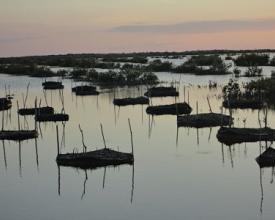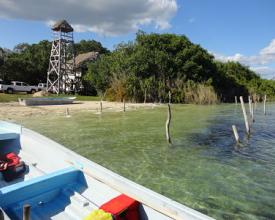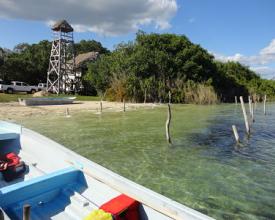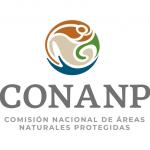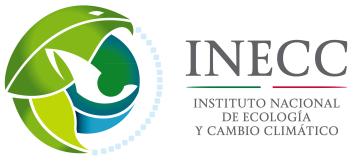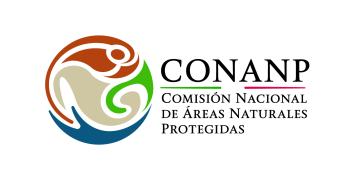
Una alianza de múltiples actores para reducir los riesgos de los peligros en cascada en Sian Ka'an.
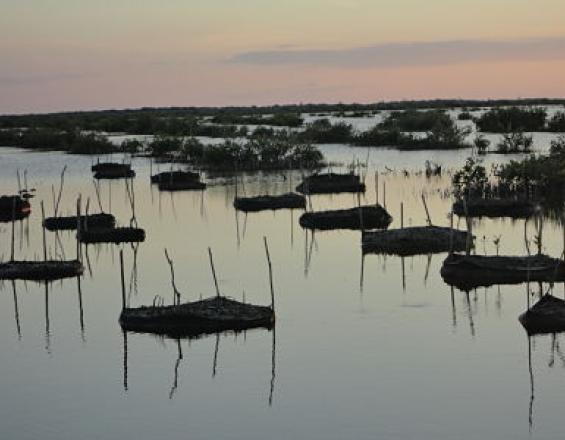
Ante los retos climáticos y las diversas presiones socioeconómicas en Sian Ka'an, la CONANP ha creado una innovadora alianza de múltiples actores para aumentar la capacidad de adaptación local mediante una estrategia de AbE basada en la rehabilitación de los manglares y la diversificación de los ingresos. Un paso clave fue implicar a los agricultores utilizando mecanismos financieros públicos específicos. La CONANP ha apoyado al sector pesquero para diversificar sus actividades productivas. El mundo académico también ha desempeñado un papel destacado en la planificación y la regulación.
Contexto
Défis à relever
El mantenimiento de la financiación a largo plazo es un gran reto, si se quiere continuar con todas las actividades relacionadas con la rehabilitación, la vigilancia y el seguimiento del ecosistema de los manglares. Es indispensable invertir en personal, infraestructuras y equipos técnicos. Para garantizar que en el futuro se mantenga un equilibrio entre las actividades turísticas, los medios de subsistencia locales y la conservación del ecosistema, es necesario estar continuamente en comunicación con las comunidades locales, implicarlas y proporcionarles apoyo técnico y moral, tanto dentro como en los alrededores de la reserva de Sian Ka'an. Rehabilitar los manglares no es barato ni rápido. No es fácil meter y sacar maquinaria de los manglares, ni transportar basura. Se necesita mucha planificación y recursos. Además, los estudios son esenciales para poder ayudar a identificar acciones de rehabilitación eficaces.
Ubicación
Procesar
Bloques de construcción
Aumentar la resistencia de los ecosistemas locales alternativos que pueden proporcionar hábitats a las especies de langosta.
Factores facilitadores
Lección aprendida
Pensar "fuera del sector": Pagos inteligentemente orientados a los agentes clave
La CONANP decidió recurrir a pagos específicos para crear mano de obra local que mantuviera y rejuveneciera los manglares, con el fin de apoyar al sector pesquero. Un objetivo obvio de los pagos y una fuente de mano de obra sería ese mismo sector pesquero. Sin embargo, la CONANP dio el inusual paso de pensar "fuera del sector", e implicar a un sector no vinculado en absoluto al problema: las comunidades agrícolas locales. La CONANP observó que los medios de subsistencia de este sector se ven cada vez más presionados por la pérdida de mercados, la reducción de las condiciones del suelo y la pérdida de los niveles tradicionales de precipitaciones como consecuencia del cambio climático. Por un lado, centrarse en este sector ha proporcionado una fuente adicional de ingresos que aumenta la capacidad de adaptación de este grupo ante los cambios en los regímenes de precipitaciones. Por otro lado, la implicación de las comunidades agrícolas, ha tenido el beneficio de introducir a estas últimas en la problemática e importancia de los ecosistemas de manglar, creando un nuevo aliado en la lucha por el aumento de la resiliencia. En otras palabras, ha apoyado el aprendizaje intersectorial y la colaboración entre dos grupos que apenas interactúan, mejorando la capacidad de adaptación a los diferentes riesgos climáticos de ambos sectores.
Factores facilitadores
Comunicación y sensibilización efectiva por parte de la CONANP para generar una visión compartida de la relevancia del manejo integral de los ecosistemas de manglar entre las comunidades agrícolas. Existencia continua de recursos financieros para pagar los servicios de las comunidades agrícolas que apoyan la rehabilitación de los manglares; Conocimiento y sensibilización de la CONANP sobre los riesgos que enfrentan las comunidades agrícolas mayas, y cuando lo necesitaron les proporcionó empleo temporal.
Lección aprendida
Hay que estar preparado para "pensar fuera del sector" en busca de nuevos aliados potenciales. En lugar de centrar la colaboración en los aliados habituales, hay que plantearse si hay otros sectores que podrían participar en la medida EbA (rehabilitación de manglares) que podrían beneficiarse de su participación (mediante la reducción de sus propios riesgos climáticos y el aumento de las fuentes de ingresos) y, a cambio, pueden promover la colaboración multisectorial y la resolución de problemas. Los instrumentos financieros o las subvenciones, cuando se gestionan mal, pueden distorsionar las capacidades locales para generar y mantener medios de vida sostenibles. El flujo continuo de tales pagos no siempre es posible a largo plazo. Por lo tanto, es importante que dichos pagos no se consideren un fin en sí mismos, sino que se apliquen de forma que apoyen, y no sustituyan, los medios de vida locales.
Aumentar la capacidad de adaptación de las empresas pesqueras comunitarias locales
Factores facilitadores
Lección aprendida
Aumentar los mercados de productos locales sostenibles procedentes de los manglares
Factores facilitadores
Lección aprendida
Hacer realidad las capacidades empresariales de las amas de casa locales para la adaptación al cambio climático
Factores facilitadores
Lección aprendida
Resolución de problemas basada en pruebas
Factores facilitadores
Lección aprendida
Impactos
1) Se han empezado a rehabilitar los manglares locales, lo que supone una mayor protección de la zona frente a las tormentas. 2) Como resultado, las langostas locales cuentan ahora con una mayor superficie de hábitat para apoyar sus primeras etapas de desarrollo, aumentando así su propia capacidad de adaptación a los peligros de las tormentas. 3) Los pescadores de langostas han aumentado su capacidad de adaptación al recibir apoyo para diversificar sus medios de vida y ofrecer oportunidades de pesca deportiva a los turistas locales, en lugar de limitarse a vender langostas a los hoteles locales y regionales. 4) Los agricultores locales han aumentado su concienciación sobre la importancia de los manglares para la salud y la resistencia del ecosistema local, y la capacidad económica de los agricultores para adaptarse a la reducción de las precipitaciones inducida por el cambio climático se ha visto impulsada por su participación en el programa de pagos por servicios ecosistémicos relacionados con la rehabilitación de los manglares.
Beneficiarios
Comunidades pesqueras locales. Comunidades agrícolas locales. Mujeres locales. Visitantes.
Objetivos de Desarrollo Sostenible
Historia
La Reserva de la Biosfera de Sian Ka'an, es uno de los puntos calientes de biodiversidad más importantes de México. Está habitada por comunidades pesqueras y agrícolas. La reserva está sometida constantemente a la presión de las actividades turísticas y de desarrollo inmobiliario. Mantener la integridad geográfica de la reserva, y por tanto los beneficios tanto para la población local como para los visitantes, es un reto a largo plazo que la CONANP y otras organizaciones asociadas se dedican a abordar. En cuanto a las amenazas climáticas, tanto los ecosistemas como las comunidades locales se enfrentan a riesgos en cascada. Un ejemplo es la creciente fuerza de las tormentas tropicales que, además de causar daños a propiedades y personas, está provocando la erosión de los bancos de arena, lo que a su vez daña algunos de los hábitats necesarios para los ciclos vitales de la langosta. Los servicios ecosistémicos que prestan los manglares de la zona se han debilitado debido a tormentas anteriores, al desarrollo de infraestructuras y a problemas de salinización. Reducir esta cascada de riesgos ha requerido alianzas innovadoras entre múltiples sectores. La CONANP ha colaborado estrechamente con la sociedad civil local y el mundo académico, y ha creado una estrategia basada en pruebas para reducir la salinidad del sistema de manglares construyendo canales bajo la carretera que reconectan los flujos de agua dulce y salada. Este fue sólo el primer paso en la rehabilitación de los manglares. La CONANP también ha promovido el rebrote natural. Ha construido "tarquinas" -pequeñas islas de sedimento atrapadas en redes- que permiten el crecimiento de nuevos mangles. Luego se excavaron corredores para aumentar el flujo natural de nutrientes y agua entre las partes existentes del sistema de manglares. También se ha llevado a cabo la recogida de basuras. La reducción de la vulnerabilidad y el aumento de la capacidad de adaptación han sido fundamentales en estos esfuerzos. La CONANP empleó a comunidades agrícolas para apoyar las actividades de rehabilitación en los manglares. Esto favorece su bienestar económico y contribuye a aumentar su resiliencia ante las precipitaciones y las pérdidas de cosechas inducidas por el cambio climático. También reduce la presión de las actividades extractivas sobre los recursos locales que, de otro modo, se habría producido como resultado de los intentos de las comunidades por contrarrestar las pérdidas en las cosechas. En el caso de las comunidades pesqueras, la CONANP apoyó la diversificación de actividades para aumentar su capacidad de adaptación a la posible reducción de las poblaciones de langosta. Se ha proporcionado formación, certificación y tutoría. Se está organizando y formando a las mujeres locales para que gestionen empresas de ecoturismo.

